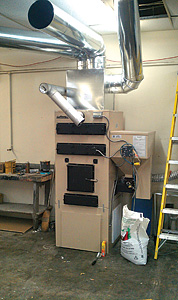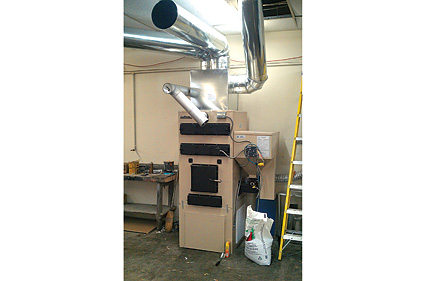
|
| Mark Norwood regularly installs biomass equipment, such as this Traeger GBU130 multi-fuel warm air furnace, which can use wood pellets or corn. |
Another reason why biomass heating may not be more popular is that HVAC contractors and engineers need more technical data about this heating equipment from the manufacturers, as well as from AHRI and ASHRAE, in order to be comfortable specifying it, said Joseph Seymour, executive director, Biomass Thermal Energy Council. “In addition, there needs to be more information out there concerning fuel consistency, as well as a consensus measure for stating the efficiency of the equipment. We’re working on all these issues right now.” (See sidebar on page 18.)
With customers expressing more interest in non-fossil fuel technology, contractors may find it worthwhile to learn a little more about this type of alternative heating system.
Looking for Alternatives
It makes sense to offer biomass furnaces, because many customers are looking for greener alternatives, and/or want to get away from the dependency on the fossil fuels, noted Sally Murrey, Alternative Heating and Fuel, Baldwin, Mich. In addition, customers are interested in achieving better comfort for less money. “At our current price of $189 per ton of wood pellets, the price for propane would have to be less than 60 cents per gallon to just break even. Also, the heat is steady, and usually warmer than a traditional forced-air furnace.”
Murrey noted that the biomass furnaces they offer usually have efficiencies around 80 percent AFUE and can burn cord wood, wood pellets, corn, coal, wheat, rye, cherry pits, and other grains. “Most of our furnace customers burn about 5 to 6 tons of wood pellets per heating season, and we sell those year-round. Some of our customers are farmers and grow their own fuel.”
Brandon Whitesell, sales and technical service manager, Energy Mill, Plainwell, Mich., agrees that biomass furnaces offer a great alternative to propane, fuel oil, and natural gas, particularly when it comes to comfort. “Where gas furnaces tend to have a ‘cold heat’ feel, meaning that as the furnace cycles on and off, you feel the few degrees change from hot to cold, cold to hot, over and over, and it is not very comfortable. Biofuel furnaces put out a much more even heat that is much cozier than gas heat. On top of that, pellet wood fuel, like wood, is carbon neutral.”
Due to the rising cost of corn, wood pellets are much more economical — and cleaner burning — than corn, added Whitesell, and they are readily available at most big box stores, as well as stores such as his own, which specialize in wood pellet burning appliances. He cautions that when buying from big box stores, care must be taken to inspect the pellets for moisture, as at these locations, most pellets are stored outside, and rain and snow can penetrate the pallet of pellets and make them unusable.
John Beavers, owner, John Beavers Mechanical Contracting, Falls, Pa., installs gas, oil, and electric heating equipment, but he likes biomass furnaces because they give customers the ability to heat their homes on their own terms, with no oil or gas companies involved. His customers often like that, too. “Everyone has their own reason for wanting a biomass furnace. Some are fighting with the utility company about unfair prices or charges, some want to ‘flip-off’ OPEC, some like the control, and some want to help the local economy and farmers. Others like the savings and are willing to work more to save more.”
That last point may be one of the biggest reasons why more homeowners do not choose biomass furnaces: they need to be cleaned regularly (if not daily) for both efficiency and safety. “I spend most of my time trying to put a little fear into buyers by telling them that they have to put bag fuel into the unit every day, and they have to clean it out once a week, because there’s a lot of ash and soot,” said Mark Norwood, president, Evergreen Heat Inc., Portland, Maine. “If you don’t clean these units, they’ll plug up with ash and not work correctly. Plus you can have chimney fires. Buyers want to hear it’s automatic and does this and that, but that’s just not true.”
For that reason, Norwood chooses his customers carefully, saying he looks for those who aren’t afraid to do a little work and get their hands dirty. Tradespeople and car mechanics are perfect, he noted, as they don’t feel that the extra work is a burden. “It’s common sense. I’m going to choose my customers just like they’re evaluating me. They have to understand that if they invest in one of these systems, they’re going to do a little work, like doing laundry or taking out the garbage. But they’re making an impact, because they’re buying their fuel locally, and they’re not using oil or propane.”
Complementary Systems
Another point that Norwood stresses to buyers is that biomass furnaces should not be used as stand-alone systems; instead, they should be employed in conjunction with existing fossil fuel heating systems. In that situation, the biomass unit can usually handle about 80 to 90 percent of the building’s heat load, and on really cold days, the existing fossil fuel system can be used to satisfy peak heating requirements. And, if there’s a problem with the biomass furnace, the customer will have a back-up heating source.
“When customers have one oil- or gas-fired unit, it has to be big enough for the coldest day, so it’s always oversized a little,” said Norwood.
“With the biomass furnace, it’s just the opposite. For example, in a 10,000-square-foot building, someone might want to install a 200,000- or 300,000-Btuh unit, but I can drop a 130,000-Btu biomass furnace in there, and it’s going to run great in the spring and fall. It will provide all the heat necessary until it gets to be about 10˚F, then the existing oil or gas equipment will help it out.”
As an example, Norwood cites a customer of his who owned a 10,000-square-foot retail space that used four 150,000-Btu propane units to heat the space. The owner was spending $20,000 each year in heating costs, until Norwood installed a single 130,000-Btu pellet furnace. Now the owner uses 20 tons of pellets and 500 gallons of propane each year instead of 8,000 gallons, and his annual fuel bill is $4,000.
Murrey noted that most biomass furnaces are add-ons anyway, because local building codes often state that biomass furnaces cannot be used as the primary heat source.
“We encourage our customers to have another source of heat, and for this reason, most of our sales consist of retrofit applications. The biomass furnaces tie right into the existing plenum, or even the main trunk line, depending on the situation. Proximity to an exterior wall is important because the less exhaust venting, the better.”
Even though the first cost of biomass furnaces is often significantly higher than oil- or gas-fired units, sales are growing thanks to increasing customer interest.
“As crude oil, propane, fuel oil, and electricity costs continually rise year after year, many are searching for alternative heat sources to replace or subsidize their existing systems. Also, many people are concerned about our environment and want to do what they can to help reduce their carbon footprint,” said Whitesell.
Seymour agreed, noting that if contractors offer customers a renewable energy option that saves them a lot of money, they’ll often select it.
“According to the 2012-2013 Winter Fuels Outlook, homeowners are expected to pay $400 more for heating oil this winter, on top of the record prices they’ve been paying the last few years. If homeowners are serious about saving money, and their contractor knows the options, they can save a significant sum by switching over to biomass. And if they want to be green and be energy efficient, this is a great way to do it.”
Sidebar: Commercial Applications
A recent research project funded by the USDA Forest Service Wood Education and Resource Center looked at the factors that drive the decisions made by building and energy design professionals when specifying HVAC equipment. The national online survey asked two questions: 1) Where do HVAC professionals look for technical information? and 2) What steps can wood-energy proponents take to increase the use of sustainable, wood-energy systems for HVAC needs in commercial construction?
The answers to these questions were detailed in the final report, titled “Architects and Energy Professionals — The Missing Link in Wood Energy.” The study stated that while HVAC professionals were interested in wood-energy technology, as it could help “plan renovations of commercial buildings that can meet the new emissions and fossil energy use targets,” they had a number of concerns. These were addressed in the following key findings:
• Building owners pay HVAC design engineers and architects to plan energy systems. Therefore, companies that produce wood-heat HVAC equipment need to focus marketing efforts on HVAC design engineers and architects. Wood-heat equipment design data must be made available to engineers and architects through traditional channels, primarily ASHRAE.
• Once HVAC design engineers and architects have facts about wood-based heating and cooling, the majority become interested in its potential as a source of renewable energy.
• HVAC systems designed most frequently by engineers require equipment with heat output between 250,000 and 6 million Btuh, a sector universally unaddressed by wood-heat equipment manufacturers in the United States.
• HVAC design engineers and architects must view wood-heat HVAC equipment as reliable, safe, and convenient with a parts, service, and fuel-supply network comparable to that of the fossil fuel systems it is replacing.
The study concluded that wood-energy businesses can develop a market in the United States’ commercial building construction and renovation sector by providing easy-to-use renewable energy options for designers working with developers, owners, and contractors. “Wood is a sustainable, near-carbon neutral, locally supplied fuel that businesses need to help reach net zero energy goals. However, the energy design professionals that responded to the surveys in this study indicated that the wood-energy industry must improve its practices and its image.”
Publication date: 11/26/2012



Report Abusive Comment